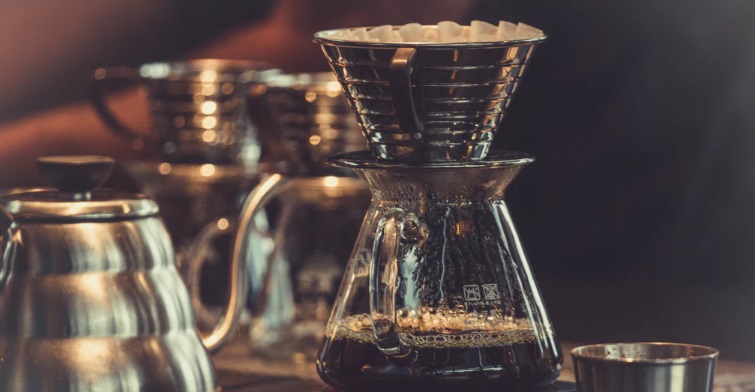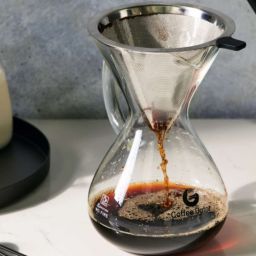
Imagine a time when coffee was a bitter, sediment-filled beverage, a far cry from the refined drink we enjoy today. This was the coffee world before 1908, the year a German housewife named Amalie Auguste Melitta Bentz revolutionized coffee brewing. Frustrated with the prevailing methods, Melitta invented the pour over technique using a simple paper filter. She punched holes in a brass pot and lined it with blotting paper from her son’s school notebook, placing ground coffee on top and pouring hot water over it.
This ingenious method not only filtered out coffee grounds but also allowed the coffee to brew in a way that enhanced its flavor and aroma. Recognizing the potential of her creation, Melitta patented her coffee filter system, laying the foundation for the modern pour over coffee brewing technique and establishing a legacy that endures in every filter and pour over device bearing her name.
Key Takeaways
- Invention by Melitta Bentz (1908): The pour over coffee method was born out of necessity and creativity by Melitta Bentz, marking the beginning of a new era in coffee brewing.
- Patenting of the Paper Filter: The introduction of the paper filter by Melitta Bentz was a game-changer, improving coffee quality and convenience.
- Rise of the Chemex Coffeemaker (1941): The Chemex, with its elegant design and unique paper filter, offered a new way to enjoy cleaner, richer coffee.
- Introduction of the Hario V60: This device became a favorite among coffee enthusiasts for its precision and control over the brewing process.
- Transition to Mainstream: What started as a niche brewing method evolved into a global phenomenon, with pour over coffee becoming a staple in coffee culture worldwide.
Evolution of Pour Over Brewing Devices
Before pour over became the artisanal coffee brewing method of choice, siphon coffee makers reigned supreme, especially in the early 20th century. These devices, known for their elaborate and somewhat theatrical brewing process, offered a unique spectacle but were cumbersome to clean and maintain. Despite their initial popularity, siphon coffee makers began to decline as simpler, more efficient brewing methods emerged.
Enter the Chemex system in the 1940s, a breakthrough in pour over coffee brewing. Its sleek design and unique paper filter technology not only simplified the brewing process but also enhanced the coffee’s flavor profile by eliminating sediments and oils. The Chemex not only made pour over brewing more accessible but also elevated it to an art form, combining functionality with aesthetic appeal.
The next significant evolution in coffee brewing came with the advent of the automatic drip coffee maker. Invented in Germany in the early 1950s, it offered a hands-off approach to coffee brewing, appealing to the convenience-driven consumer market. The automatic drip coffee maker underwent various iterations, incorporating timers, programmable settings, and even built-in grinders, making it a staple in homes and offices worldwide.
Pour Over Coffee in Europe and North America
The popularity of pour over coffee spread across continents, significantly influenced by the cafe culture that thrived in central Europe. In the late 19th and early 20th centuries, cafes in cities like Vienna and Paris became hubs of intellectual and social activity, where the quality of coffee was paramount. This environment fostered a deep appreciation for the art of coffee brewing, setting the stage for innovations like Melitta Bentz’s paper filter, which would revolutionize coffee brewing.
In North America, the pour over method gained traction mid-20th century, notably with the introduction of the Chemex. Its elegant design and superior brewing quality caught the attention of American coffee lovers, marking a departure from the more automated coffee brewing methods prevalent at the time. This shift towards pour over brewing in the US echoed the global trend towards appreciating finer, more artisanal coffee experiences.
Modern Pour Over Brewing Techniques
When it comes to modern pour over brewing, two names stand out for their innovation and the quality of coffee they produce: the Hario V60 and the Chemex Coffeemaker. Each brings its unique flair to the pour over method, catering to the nuanced preferences of coffee enthusiasts worldwide.
Hario V60: This Japanese brewer has garnered a cult following for its design and the control it offers over the brewing process. The V60’s signature feature is its cone shape, complemented by spiral ridges lining the interior. These ridges not only aid in air flow during brewing but also ensure the water flows towards the center, extending contact time with the coffee grounds. This design, combined with the use of thin paper filters, allows for a crisp, clean cup of coffee that highlights the subtle nuances of the coffee’s flavor profile. The technique involves a precise pour over the grounds, starting from the center and spiraling out, then back in, ensuring even saturation for optimal extraction.
Chemex Coffeemaker: The Chemex brings elegance to pour over brewing with its hourglass shape made from high-quality, non-porous glass. Its use of a thicker, bonded paper filter is key to its brewing magic, producing coffee that is smooth and free of bitterness. The Chemex’s design is not just about aesthetics; it also functions to keep the coffee warmer for longer. Brewing with a Chemex involves a gentle pour over the coffee grounds, allowing for a bloom phase before continuing the pour in stages to extract the full flavor.
Importance of Coffee Roasts and Grounds: The choice of coffee roast and grind size is crucial in pour over brewing. Light to medium roasts are preferred for their ability to retain the original flavors of the bean, which are more pronounced in the pour over method. The grind size for both Hario V60 and Chemex should be medium to medium-coarse, resembling sea salt in texture. This allows for the right pace of water flow through the grounds, ensuring thorough extraction without over-extracting, which can lead to bitterness. The freshness of the grounds is also vital; freshly ground coffee will always yield a more aromatic and flavorful cup.
In pour over brewing, every detail matters, from the temperature of the water (ideally between 195°F and 205°F) to the pouring technique. The beauty of the Hario V60 and Chemex lies not just in the design of the brewers themselves but in the ritual of brewing.
FAQs
How long should my coffee bloom?
The coffee bloom is a crucial step in the pour over method, releasing trapped gases and preparing the coffee grounds for optimal extraction. Aim for a 30-second bloom time. Pour just enough water to wet the grounds, then wait before continuing your pour.
What’s the best brewing time?
The total brewing time should be between 2 to 4 minutes. This range allows for proper extraction without over-extraction, which can lead to bitterness.
Which filter type should I use?
The filter choice can influence the taste of your coffee. Paper filters, used in Hario V60 and Chemex, offer a clean, crisp taste by filtering out oils and fines. Metal filters allow more oils to pass through, giving the coffee a fuller body. Cloth filters are a middle ground, offering clarity with a slight increase in body.
Should I grind my own beans or use pre-ground coffee?
Grinding your own beans just before brewing is best for freshness and flavor. Pre-ground coffee can lose its nuances and become stale quicker. If you prefer convenience or don’t own a grinder, opt for freshly ground coffee from your local roaster and use it within a week.
Final Thoughts
The journey of pour over coffee from a niche brewing method to a beloved ritual around the world speaks volumes about its appeal. This technique, championed by innovators like Melitta Bentz and refined through devices like the Chemex and Hario V60, has elevated the coffee drinking experience. It encourages a mindful approach to brewing, where every variable, from grind size to water temperature, is considered to extract the perfect cup.









